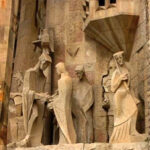Life within the President’s House in Philadelphia during the 1790s was a whirlwind of activity centered around the George Washington Family. More than just a residence, it was the bustling hub of a new nation, accommodating around thirty individuals. This included George and Martha Washington, their grandchildren Eleanor “Nelly” Parke Custis and George Washington “Wash” Parke Custis, and key household figures like Tobias Lear, Washington’s trusted secretary. Beyond family, a substantial staff of both free and enslaved servants was essential to maintain the household’s demanding rhythm, managing everything from cleaning and cooking to errands and stable duties.
The Washingtons’ home was a stage for both private family life and public duties. Formal levees were a Tuesday tradition, welcoming any suitably dressed white man to meet the President in the state dining room. Thursdays shifted to more exclusive state dinners, hosting Supreme Court Justices, foreign ambassadors, members of Congress, and prominent local families. Martha Washington further shaped the social landscape by hosting drawing rooms each Friday, creating a more relaxed setting for men and women to socialize. Holidays like New Year’s Day and July 4th saw the doors flung open to the public, with thousands of citizens filling the hallways to partake in refreshments and enjoy the festive atmosphere, often accompanied by outdoor music. Despite the demanding schedule, the family carved out moments for leisure, attending theater performances, circuses, and historical site visits, and enjoying leisurely carriage rides around Philadelphia.
Martha Washington played a pivotal role in both the private and public spheres of the household. As the hostess, she meticulously planned menus and oversaw the enslaved chef Hercules in meal preparation, ensuring every event ran smoothly. Her focus extended to creating a warm and inviting atmosphere, encouraging engaging conversations amongst guests. Crucially, Martha consciously cultivated an image of the ideal mother and grandmother, embodying modesty, generosity, and hospitality, all while dedicating herself to raising her grandchildren as virtuous citizens crucial for the young republic’s future. Her approach to the First Lady role, centered around social duties and domestic virtues, profoundly influenced the position for generations, even as later First Ladies expanded their roles to include social and educational advocacy.
The seamless execution of every event, from grand levees to intimate dinners, depended heavily on the tireless efforts of both white employees and enslaved African Americans. While President Washington’s $25,000 annual salary was considerable for the era, it was intended to cover all household expenses, including housing, food, entertainment, travel, fuel, and labor. The Washingtons’ ability to maintain such an opulent lifestyle was directly supported by the forced labor of enslaved people. However, this system faced challenges in Philadelphia. Attorney General Edmund Randolph alerted Washington to a Pennsylvania law that granted freedom to enslaved individuals residing in the state for six continuous months. To circumvent this law and maintain their enslaved workforce, George and Martha Washington implemented a rotation system, regularly sending enslaved people back to Virginia before the six-month period elapsed, effectively resetting the legal clock and preventing their legal freedom.
Despite these measures, the desire for freedom burned brightly within the enslaved community. In May 1796, Ona Judge, Martha Washington’s personal maid, bravely escaped. During a family supper, she quietly left the President’s House and found passage on a ship departing from Philadelphia’s bustling port. Ona successfully reached New Hampshire, where she built a life, married, raised a family, and lived as a free woman until her death in 1848. The following February, on George Washington’s birthday, Hercules, the skilled chef, also seized his freedom, disappearing into the night and making his way to New York City. He changed his name and successfully evaded recapture. Martha Washington was particularly determined to have both Ona and Hercules returned to bondage, but despite persistent efforts, neither was ever forced back into slavery.
This glimpse into the George Washington family’s life in Philadelphia reveals a complex picture: a family at the heart of a new nation’s social and political life, marked by both grand hospitality and the stark realities of slavery, and punctuated by the courageous pursuit of freedom by those held in bondage within their household.

